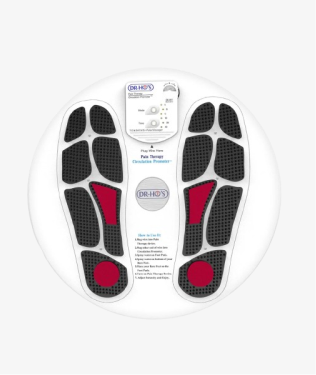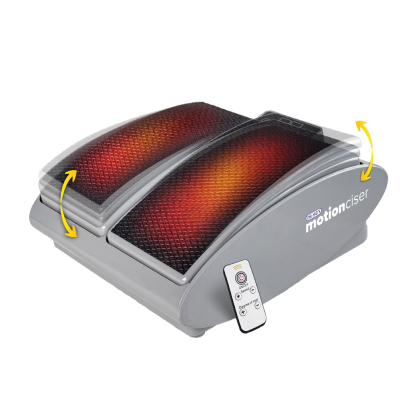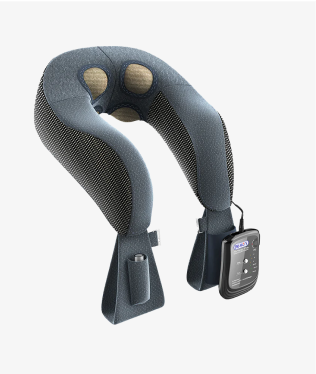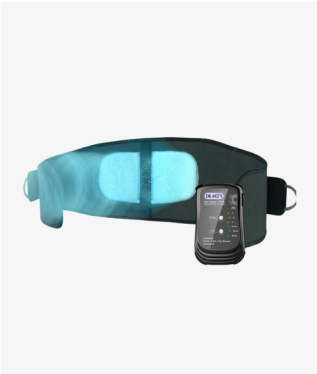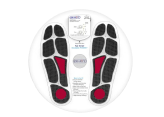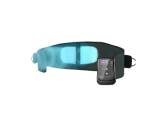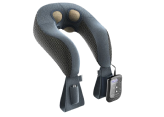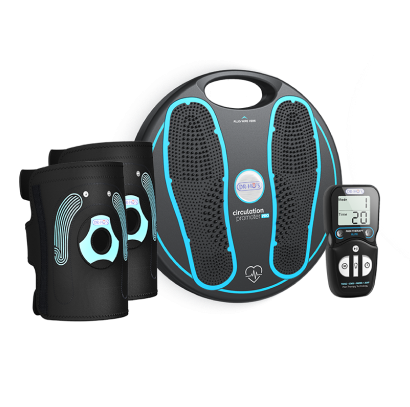When shopping for pain relief devices, you've likely encountered dozens of products that look nearly identical from the outside—sleek units with electrode pads and digital displays. Yet beneath these similar casings lie fundamentally different technologies with distinct purposes, capabilities, and price points. This similarity in appearance creates significant confusion for consumers trying to understand whether they need TENS, EMS, or something more comprehensive.
The challenge deepens when you realize that pain rarely fits into neat categories. Your back pain might involve both nerve irritation and muscle tension. Your knee discomfort could stem from joint issues compounded by weakened supporting muscles. This is where understanding the science behind different electrical stimulation technologies becomes crucial for making an informed decision.What is TENS technology?
TENS stands for Transcutaneous Electrical Nerve Stimulation—a proven, drug-free method of pain management that uses gentle electrical impulses to provide temporary relief from various types of discomfort. This non-invasive therapy has been used by healthcare professionals for decades and is now available for home use through FDA-cleared devices.
How does TENS work?
TENS therapy works through two primary mechanisms that target your body's natural pain processing systems:
-
Gate control theory: The electrical impulses stimulate large nerve fibers that essentially "close the gate" on pain signals traveling to your brain. When these larger, faster nerve pathways are activated by electrical stimulation, they can effectively block smaller pain signals from reaching your brain—similar to how rubbing an injury instinctively provides relief for sore and aching muscles (Journal of Pain Research, Physiopedia).
-
Endorphin release: TENS therapy stimulates your body's production of endorphins, natural pain-relieving chemicals that work similarly to morphine. Clinical research confirms that electrical stimulation techniques can raise endorphin levels, contributing significantly to their pain-relieving effects (Cleveland Clinic, UIHC).
What injuries/conditions does TENS help with?
TENS has been studied across a wide variety of pain conditions, with promising results for:
-
Chronic and acute pain conditions
-
Neck and shoulder tension
-
Arthritis and joint pain
-
Muscle tension and soreness
-
Muscle strains and sprains
-
Sports injuries
-
Tendonitis and bursitis
-
Knee pain
-
Foot and ankle pain (including plantar fasciitis)
What are the limitations of simple TENS machines?
While effective for nerve-related pain, traditional TENS units don't address underlying muscle dysfunction that often contributes to chronic pain conditions. They provide temporary relief but don't actively work to improve muscle function or circulation that could support longer-term wellness.
What is EMS technology?
Electrical Muscle Stimulation (EMS) represents a different approach to electrical therapy. Rather than targeting nerve pathways to relieve pain, EMS focuses on the muscular system to stimulate contractions and promote muscle function.
How does EMS work?
EMS devices send electrical signals directly to motor nerves, causing muscles to contract and relax in controlled patterns. What makes EMS particularly effective is its ability to activate muscle fibers differently than regular exercise. While voluntary movement typically engages muscles gradually, EMS can simultaneously activate a larger percentage of muscle fibers, including the powerful fast-twitch fibers that are harder to engage through normal activity (Medicine).
This synchronized muscle activation helps explain why EMS can be so effective for muscle rehabilitation and strengthening. When combined with gentle movement or stretching, EMS becomes even more beneficial, as studies show this combination approach can lead to greater improvements in muscle function and strength compared to either method alone. These contractions help maintain or improve muscle function, temporarily increase local blood circulation, and address muscle-related issues that can contribute to pain and dysfunction.What injuries/conditions does EMS help with?
Electric Muscle Stimulation technology serves two primary therapeutic areas:
-
Muscle strength and rehabilitation: Clinical research demonstrates EMS's effectiveness for preserving and improving muscle function in various populations. Studies involving critically ill patients, elderly individuals, and those with chronic conditions like heart failure, COPD, and sarcopenia show that EMS can help maintain or even improve muscle mass and function. This makes EMS particularly valuable for addressing muscle atrophy from disuse, supporting post-surgical recovery, and helping individuals regain strength when traditional exercise may be challenging or limited. (Crit Care Res Pract., Medicine)
-
Athletic performance and healthy adults: For active individuals, EMS serves as a powerful complement to conventional exercise. Research shows that when EMS is used alongside traditional training, it can lead to greater gains in muscle contraction efficiency and, in some cases, increased muscle mass and strength. Athletes utilize EMS for targeting specific muscle groups, enhancing performance, assisting recovery, and supplementing their regular training routines to achieve results that might be difficult to accomplish through exercise alone. (Medicine)
What are the limitations of simple EMS devices?
While excellent for muscle-related issues, standalone EMS devices don't directly address nerve pain or provide the immediate pain relief that many people seek. They work more slowly to build muscle function rather than providing rapid symptom relief.
The problem with single-mode approaches
The traditional debate between TENS and EMS units presents a false choice that doesn't reflect how pain actually works in the human body. Most chronic pain conditions involve complex interactions between nerves, muscles, circulation, and inflammation. Choosing between TENS or EMS means addressing only part of the problem.
Consider common scenarios:-
Lower back pain often combines nerve irritation with muscle tension, muscle spasms, and reduced circulation
-
Arthritis involves joint inflammation, muscle weakness, and nerve sensitivity
-
Sports injuries typically affect muscles, nerves, and local blood flow simultaneously.
Advanced 4-in-1 Technology: The next level of pain relief
DR-HO'S devices incorporate sophisticated AMP 4-in-1 Technology that addresses acute or chronic pain relief from multiple angles simultaneously, moving beyond the traditional TENS vs EMS debate into integrated therapy.
TENS, EMS, and more: Four technologies working together
Rather than limiting yourself to choosing between TENS or EMS, advanced 4-in-1 technology eliminates this compromise entirely by delivering all these benefits in a single, sophisticated device:
-
TENS (Transcutaneous Electric Nerve Stimulation): Sends low-voltage electrical impulses through your skin to stimulate sensory nerve endings and disrupt pain signals before they reach your brain, providing immediate relief.
-
EMS (Electrical Muscle Stimulation): Causes muscles to contract and relax rhythmically, which can help release tight knots, promote muscle relaxation, and improve blood circulation to the area.
-
NMES (Neuromuscular Electrical Stimulation): Targets specific nerve pathways to stimulate muscle contractions, helping to re-educate muscles that have become dysfunctional.
-
Auto-Modulating Pulses (AMP): This system continuously varies the electrical impulses, ensuring your body doesn't become accustomed to a single pattern. This helps ensure sustained effectiveness throughout your treatment and prevents the diminishing returns often experienced with conventional devices.
The Auto-Modulating Pulses technology represents a significant advancement in electrical stimulation, automatically varying the pulse patterns to prevent your body from adapting to the stimulation. This innovation helps maintain effectiveness over time while ensuring deeper tissue penetration for more comprehensive relief.
Which DR-HO’S device is right for you?
Each of our devices incorporates our proprietary AMP 4-in-1 Technology, but they're designed to optimize that advanced stimulation for different therapeutic needs and user preferences.
Best for lower back pain: DR-HO’S Triple Action Back Belt
Lower back pain requires targeted therapy that addresses both the deep muscles supporting your spine and the complex nerve pathways in the lumbar region. The DR-HO'S Triple Action Back Belt is specifically engineered for optimal back pain relief.
 This wearable device combines our proprietary AMP 4-in-1 Technology with ergonomic design that provides supportive compression while delivering targeted electrical stimulation. The electrode placement is optimized for lumbar anatomy, ensuring stimulation reaches the deep muscle groups that support spinal alignment.
This wearable device combines our proprietary AMP 4-in-1 Technology with ergonomic design that provides supportive compression while delivering targeted electrical stimulation. The electrode placement is optimized for lumbar anatomy, ensuring stimulation reaches the deep muscle groups that support spinal alignment.
Why it's ideal for back pain:
-
Hands-free operation allows you to move naturally during therapy sessions
-
Integrated support helps maintain proper posture while providing pain relief
-
Targeted electrode placement reaches deep lumbar muscles
-
Effective for both lower back pain and sciatica symptoms
-
Can be worn discreetly under clothing for all-day relief
Best for neck & shoulder pain: DR-HO’S Neck Pain Pro
Neck and shoulder tension often involves complex muscle interactions and nerve pathways that require precise, targeted stimulation. The DR-HO’S Neck Pain Pro is the only neck support cushion with built-in muscle and nerve stimulation designed specifically for cervical spine anatomy.

This innovative device provides ergonomic support while delivering targeted electrical stimulation to the specific muscle groups responsible for neck and shoulder tension. The design accounts for the delicate nature of cervical vertebrae while providing effective therapy.
Why it's ideal for neck and shoulder pain:-
Cushion design provides proper cervical support during therapy sessions
-
Targeted stimulation reaches deep neck and shoulder muscles
-
Perfect for desk workers and those with chronic neck tension
-
Combines postural support with active pain relief therapy
-
Convenient for use while reading, watching TV, or resting
Best for active lifestyles & multiple pain points: DR-HO’S Pain Therapy System 4-Pad
Active individuals often experience varying pain patterns depending on their activities, sports, or daily routines. The DR-HO’S Pain Therapy System 4-Pad provides the flexibility to address multiple pain points with one comprehensive device.

This versatile system features four independent electrodes that can be configured for simultaneous therapy of multiple areas or focused therapy on larger muscle groups. The dual-channel design allows different intensity levels for different body regions during the same session.
Why it's ideal for active lifestyles:
-
Four-pad system offers maximum flexibility for a variety of therapy
-
Dual channels allow simultaneous therapy of multiple areas
-
Compact, portable design perfect for travel or gym bags
-
Effective for sports injuries, post-workout recovery, and daily activity-related pain
-
Suitable for treating neck, shoulder, elbow, wrist, back, hip, leg, knee, ankle, and foot pain
Best for foot & leg pain: DR-HO'S Circulation Promoter
The DR-HO’S Circulation Promoter is our most popular nerve and muscle stimulator, specifically engineered to address the unique challenges of lower extremity pain and circulation issues. This Health Canada-registered medical device harnesses our patented AMP Technology to deliver targeted relief for complex foot and leg conditions.

Why it's ideal for foot and leg pain:
-
Medical-grade pain relief for muscle pain, arthritis pain, neuropathy pain, and sciatica pain
-
Specialized stimulation patterns designed for lower extremity circulation enhancement
-
Effective for reducing swelling and improving blood flow in legs and feet
-
Targets the complex nerve pathways responsible for lower extremity discomfort
-
Proven effectiveness for circulation-related pain conditions
Best for advanced pain relief: DR-HO'S Pain Therapy System Pro
Discover the next level of pain relief with the revolutionary DR-HO’S Pain Therapy System Pro, an advanced evolution that surpasses previous models through superior features and enhanced therapeutic performance. This sophisticated device establishes a new standard in at-home pain management by optimizing our proprietary AMP Technology for maximum therapeutic versatility.
 The Pain Therapy System Pro features four comprehensive coverage pads and six unique therapy modes that deliver a diverse range of therapeutic sensations. The seamless integration of EMS, TENS, and our advanced AMP Technology creates a synergistic approach that works with your body's natural healing processes to provide superior temporary relief through enhanced nerve and muscle interaction.
The Pain Therapy System Pro features four comprehensive coverage pads and six unique therapy modes that deliver a diverse range of therapeutic sensations. The seamless integration of EMS, TENS, and our advanced AMP Technology creates a synergistic approach that works with your body's natural healing processes to provide superior temporary relief through enhanced nerve and muscle interaction.
Why it's ideal for advanced pain relief:
-
Ten pads plus foot therapy pads provide comprehensive coverage for multiple pain points simultaneously
-
Six unique therapeutic modes offering diverse therapy sensations and approaches
-
Enhanced AMP Technology integration for superior nerve and muscle stimulation
-
Advanced stimulation patterns that encourage optimal circulation and muscle function
-
Revolutionary design that sets new standards for at-home pain management effectiveness
Safety, usage, and maximizing benefits
To ensure optimal results and safety, DR-HO’S pain therapy devices should be used according to established medical device guidelines. Sessions typically last 20-30 minutes, though the Pro model offers adjustable auto-shutoff settings for 20, 30, or 40-minute therapy sessions.
Best practices for effective use
-
Always start with the device turned off when positioning your feet on the footpads or when putting the gel pads on your body
-
Begin with the lowest intensity setting and gradually increase to your comfort level
-
Ensure the footpads or the gel pads are properly moistened with water for optimal conductivity
-
Use the device on clean, dry skin for best electrode contact
-
Never use the device while sleeping or when you cannot actively monitor the therapy
Important safety considerations
Your DR-HO'S device is FDA-cleared and Health Canada registered, designed with multiple safety features. However, certain precautions ensure safe, effective use:
-
Do not use if you are pregnant
-
Individuals with cardiac concerns should consult their healthcare provider before use
-
Do not use with a pacemaker or similar electronic medical device
-
Avoid use on irritated, broken, or wounded skin
-
If pain persists, worsens, or is accompanied by concerning symptoms such as swelling, redness, or fever, consult a healthcare provider
Areas to avoid
Never place electrodes on or near the eyes, mouth, front of the neck, directly over the spinal column, or any areas with tumors.
Maximizing your results
For optimal therapeutic benefits, use your DR-HO’S pain therapy device consistently as part of your daily wellness routine. Many users experience immediate relief, though results may vary depending on individual conditions and usage frequency. The 100-day satisfaction guarantee on our devices allows you to experience the full benefits risk-free!
Making an informed decision in a confusing market
The electrical stimulation device market is filled with products that appear similar but deliver vastly different results. Understanding the technology behind the device—not just its appearance—is crucial for making an effective choice.
While traditional devices force you to choose between TENS for pain relief or EMS for muscle function, DR-HO’S advanced 4-in-1 technology eliminates this compromise. By working with your body's nerve pathways, muscle systems, and natural healing processes simultaneously, integrated approaches provide more comprehensive relief for chronic or acute pain that addresses the complex nature of most pain conditions.Disclaimer: DR-HO'S content is intended for informational purposes only and should not be taken as medical advice. Please consult a certified medical professional for diagnosis and treatment recommendations.


